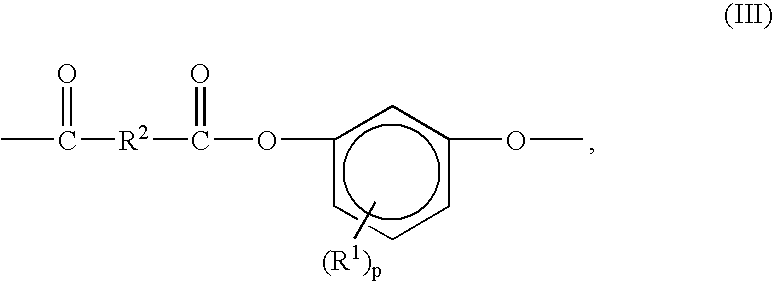Weatherable multilayer resinous articles and method for their preparation
a multi-layer resin and resinous article technology, applied in the field of weatherable multi-layer resinous articles and their preparation, can solve the problems of long-term color instability of polymeric articles, detracting from their transparency and attractiveness, and loss of gloss, etc., and achieves the effect of reducing the number of polymer articles
- Summary
- Abstract
- Description
- Claims
- Application Information
AI Technical Summary
Benefits of technology
Problems solved by technology
Method used
Image
Examples
example 1
[0065]Films of poly(resorcinol isophthalate / terephthalate) (1:1 molar ratio of isophthalate to terephthalate), about 40 microns (μ) thick, were deposited on glass plates by dissolving 10 grams (g) of the polyester in 40 milliliters (ml) of chloroform, drawing onto the plate using a 305-micron doctor blade and drying in air. The films were applied to the surfaces of samples of various colors of a bisphenol A polycarbonate-PBT blend commercially available from General Electric Plastics under the trade designation XENOY 1731, and the resulting structures were heated in a Carver press at about 184-198° C. for 2 minutes, at a pressure of 1.8 metric tons, producing multilayer articles with good adhesion between the layers.
[0066]The samples were exposed to weathering in an Atlas Ci35a xenon arc weatherometer equipped with borosilicate inner and outer filters at an irradiance of 0.77 W / m2 at 340 nm. The temperatures were: black panel 70° C., dry bulb 45° C., wet bulb depression 10° C. The c...
example 2
[0069]A series of articles with comparable layer thicknesses was prepared as described in Example 1, in which the substrates were commercially available clear and white-pigmented bisphenol A polycarbonates, designated “PCC” and “PCW”, respectively; the polycarbonate-polyester blends of Example 1, colored black and designated “PC-PE”; white ABS copolymers, designated “ABS”; and bisphenol A polycarbonate-ABS copolymer blends, colored white and designated “PC-ABS”, all commercially available from General Electric Plastics. As coating layers, there were used block copolyester-carbonates containing bisphenol A carbonate units and resorcinol iso / terephthalate units similar to those of Example 1, said block copolyestercarbonates containing 50% and 80% polyester moieties, designated “PEC-50” and “PEC-80”, respectively. There was good adhesion between the layers in each instance.
[0070]The articles were evaluated for gloss as described in Example 1, except that the second series of gloss read...
example 3
[0073]A series of articles was prepared by the method of Example 1, using as second layers commercially available clear and pigmented sheets of commercially available bisphenol A polycarbonates having thicknesses of about 250μ, the pigments employed being titanium dioxide, carbon black and a yellow pigment package, and as the coating layer the arylate polymers of Examples 1-2 (“PE” and “PEC-50”, respectively). The multilayer intermediate articles thus prepared were placed in an cavity and various bisphenol A polycarbonate-containing resins designated as in Example 2 were injected behind them at an injection temperature in the range of 270-290° C. and molded at an injection boost pressure of 8274 kPa and an injection hold pressure of 6895 kPa, a hold time of 6 seconds (sec) and a cooling time of 20 sec to produce multilayer in-mold decorated articles, whereupon the second layer became an intermediate layer between the substrate and coating layer. The articles were evaluated for gloss...
PUM
| Property | Measurement | Unit |
|---|---|---|
| crystalline melting temperature | aaaaa | aaaaa |
| temperatures | aaaaa | aaaaa |
| vapor pressure | aaaaa | aaaaa |
Abstract
Description
Claims
Application Information
 Login to View More
Login to View More - R&D
- Intellectual Property
- Life Sciences
- Materials
- Tech Scout
- Unparalleled Data Quality
- Higher Quality Content
- 60% Fewer Hallucinations
Browse by: Latest US Patents, China's latest patents, Technical Efficacy Thesaurus, Application Domain, Technology Topic, Popular Technical Reports.
© 2025 PatSnap. All rights reserved.Legal|Privacy policy|Modern Slavery Act Transparency Statement|Sitemap|About US| Contact US: help@patsnap.com



